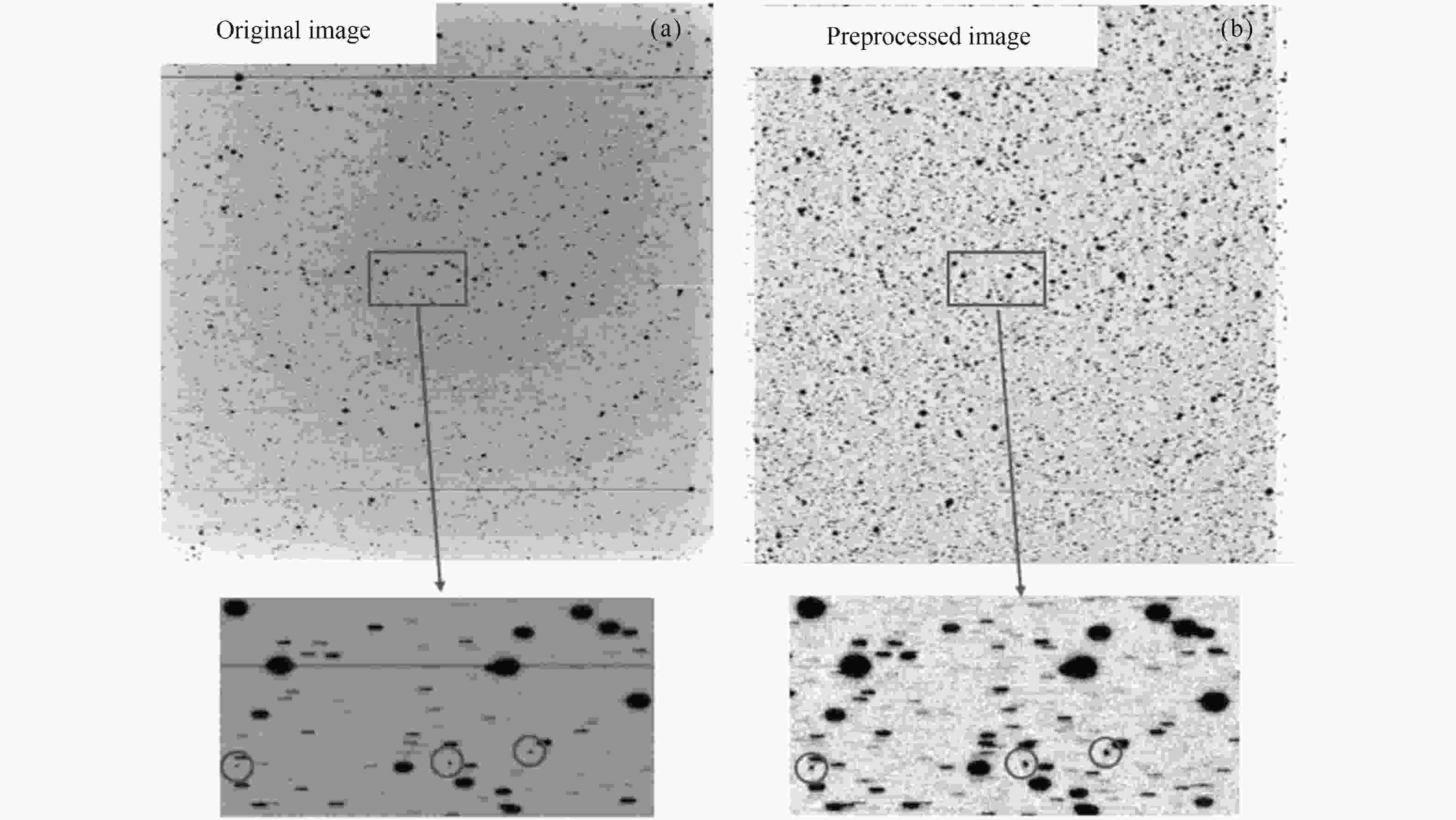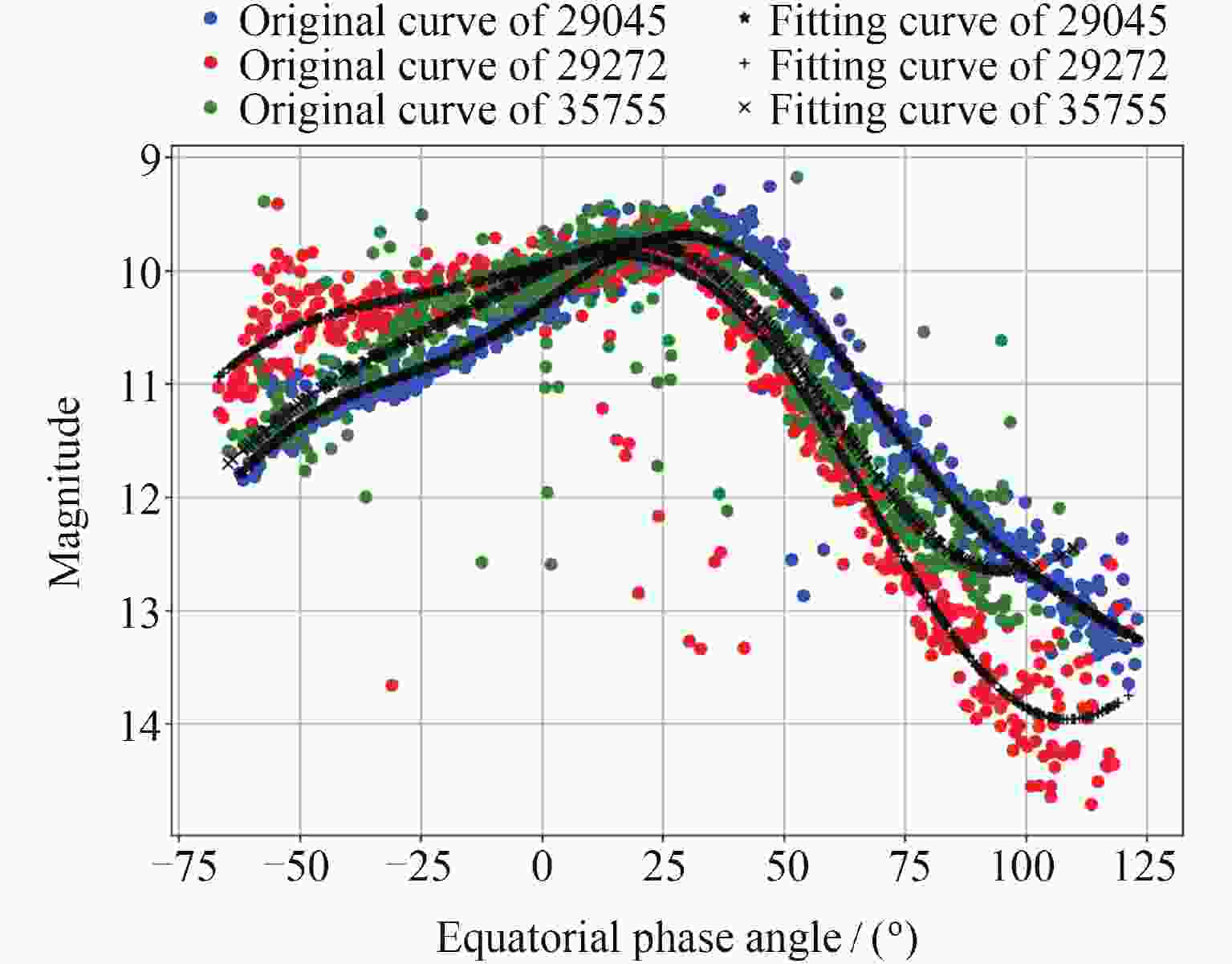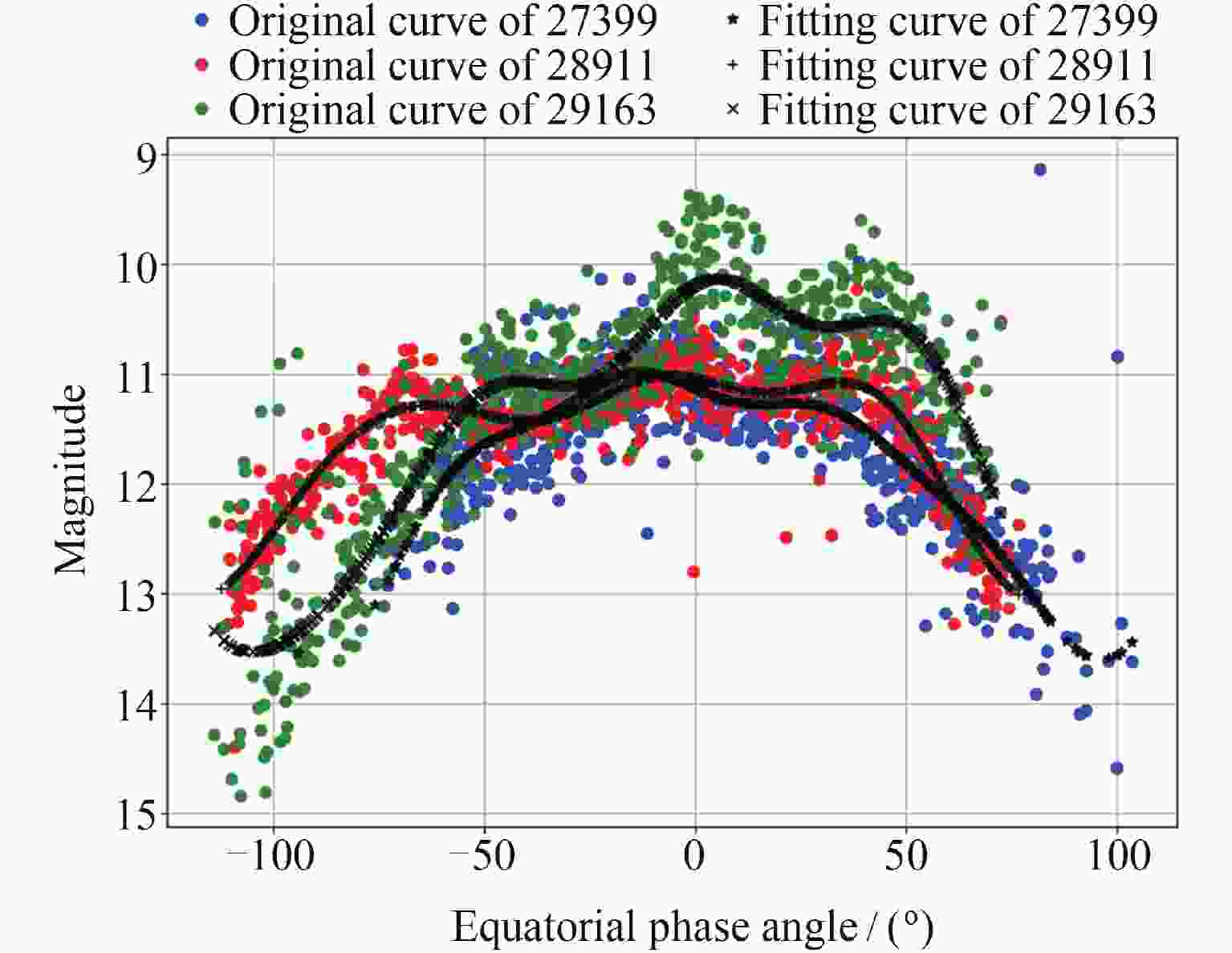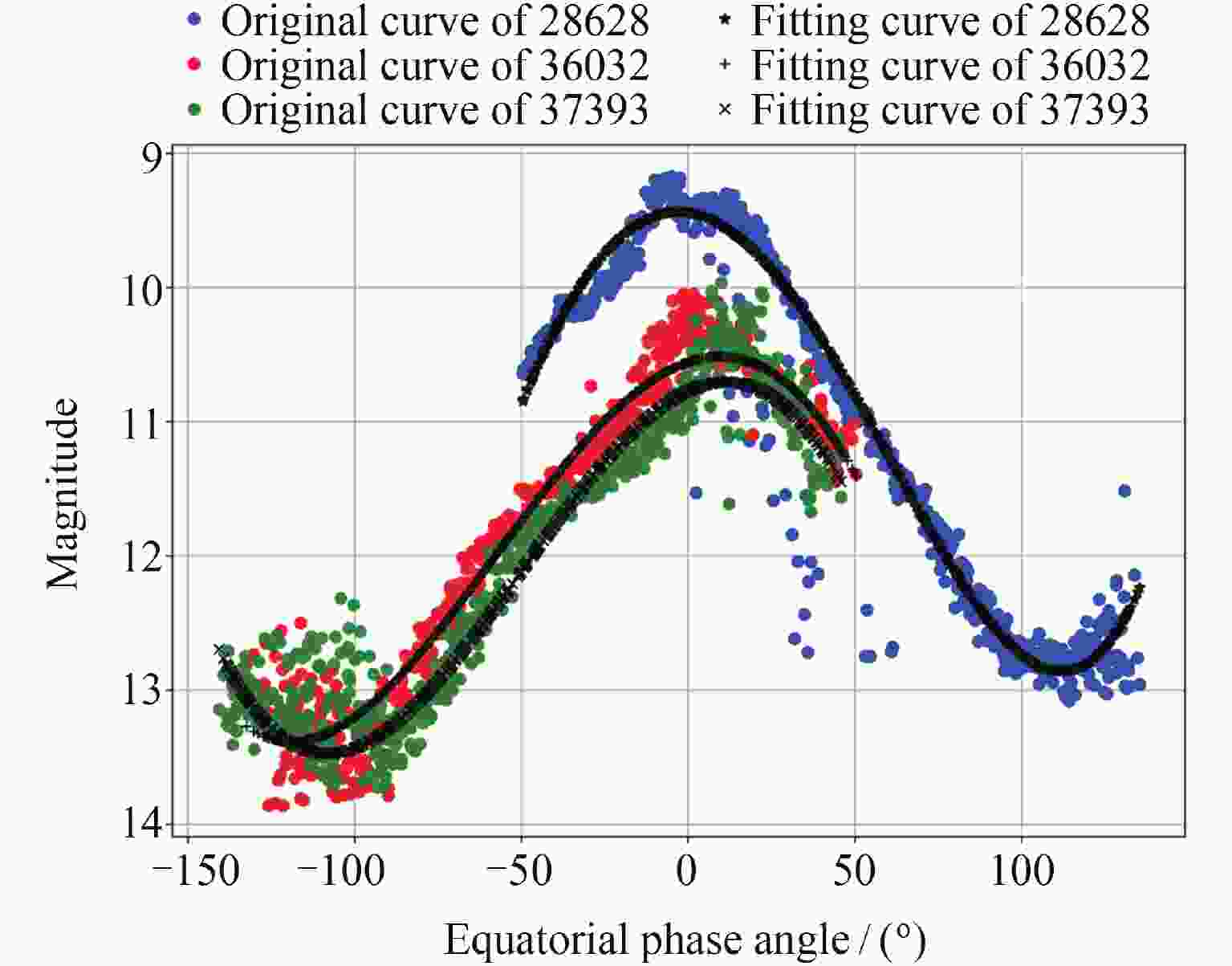FocusGEO望远镜观测地球同步轨道目标的光度特性分类
doi: 10.11728/cjss2022.01.200928086 cstr: 32142.14.cjss2022.01.200928086
GEOS Photometric Signature Classifications Based on Observations of FocusGEO Telescopes
-
摘要:
基于FocusGEO望远镜2017年12月至2019年6月的测光观测数据,开展台站上空地球同步轨道(GEO)目标光度曲线的分类研究。通过对GEO卫星光度曲线特征的统计分析,建立了一种全新的GEO卫星分类系统,确定了各类GEO卫星光度曲线的占比,分析了光度特征类别与卫星平台的相关性。本研究将197颗GEO卫星的光度曲线分为六类,其中约90%的卫星可归为三类:典型类、BSS类和Ekspress类。光度特征分类与卫星平台无直接的相关性,但同一类别中平台相同或相近的卫星,具有相似的光度曲线。该分类系统可为位置相近的多个GEO目标的准确识别提供辅助手段,为目标异常监测和物理特性研究提供依据,对空间态势感知具有重要意义。
Abstract:Ground-based optical-electrical observation is the main approach to obtain the Geostationary Earth Orbit (GEO) targets’ optical characteristics. Light curve classification was studied based on the photometry observations of FocusGEO telescope at Lijiang Station from December 2017 to June 2019. A new classification system was introduced based on the statistical analysis of GEO satellite light curve features. Moreover, the correlation between light curve classification and satellites’ bus type was analyzed. Results show that photometric signatures of 197 GEO satellites can be classified into six classes and each class can be qualitatively explained by the actual satellite structure. Approximately 90% of these satellites appear to belong to three of six different classes. However, light curve classification has no significant correlation to satellites’ bus types, but for the satellites with the same or similar bus types in each class, the light curves resemble each other. The classification system can aid to identify cluster GEO targets and provide the basis for anomaly detection and physical characteristics research, which is of great significance for space situational awareness.
-
Key words:
- GEO targets /
- Photometric signature /
- Classification system /
- Bus type
-
图 3 第一类曲线特征示例( 卫星26559、39727、41380的相位角序列光度曲线) 。拟合曲线采用多项式拟合
Figure 3. Examples of Class 1 photometric signatures (Light curves of satellites 26559, 39727 and 41380). The black curves are fitted using the polynominal fitting method. The sparse data near zero phase angle are due to the variation of solar declination angle
表 1 光度特征分类结果
Table 1. Results of classification of photometric signatures
类别 分类 特点 数量 比例/
(%)第一类 典型类 仅在0°有亮度峰值,两边近似对称且单调下降 99 50.25 第二类 第二典型类 曲线不关于0°对称,在20°~40°之间有亮度峰值,两边单调下降 6 3.05 第三类 BSS类 曲线对称,在第一类的基础上,在±40°或60°有极大值 33 16.75 第四类 A2100类 曲线对称,在0°有极小值,±40°有极大值,呈M形 12 6.09 第五类 Ekspress类 曲线不对称,在第一类的基础上,在100°或–100°有极小值 41 20.81 第六类 特殊类 曲线不对称,呈不规律变化 6 3.05 表 2 光度特征分类结果比较
Table 2. Comparisons of results of photometric signature classification
本文结果 文献[3]结果 分类 特点 比例/(%) 分类 特点 比例/(%) 典型类 仅在0°相位角有亮度峰值,两边近似对称且单调下降 50.25 典型类 0°附近有峰值,两边呈对称、平滑单调形式 47.2 第二典型类 曲线不关于0°对称,在20°~40°之间有亮度峰值,两边单调下降 3.05 A2100类 0°附近有极小值,两边的光度曲线以不同的平滑方式增加;在±40°左右,曲线平滑衰减,多数曲线不完全对称 30.6 BSS类 曲线对称,在第一类的基础上,在±40°或60°有极大值 16.75 通信星类 在典型类基础上,±40°上有极小值 5.6 A2100类 曲线对称,在0°有极小值,±40°有极大值,呈M形 6.09 BSS702 C类 在典型类基础上,±60°上有极大值,极大值比通信星类更亮更宽 2.8 Ekspress类 曲线不对称,在第一类的基础上,在100°或–100°有极小值 20.81 特殊类 关于0°对称性弱,曲线变化不平稳 13.9 特殊类 曲线不对称,呈不规律变化 3.05 - - - 表 3 本文分类中涉及的GEO卫星平台类型统计结果
Table 3. Statistic results of bus types of GEO satellites related to our classification
No. 平台类型 所属国别 卫星编号 数目 1 A2100 USA 25894、26559、27603、27632、28154、29045、29272、32019、32767、
35755、37207、37481、37776、38331、38332、40887、4316217 2 AMOS Israel 39237 1 3 AS-4000、7000 USA 23839、 24957 2 4 HS-601、GEM、BSS-702 USA 24732、25071、25462, 25630、25657、26388、26451, 26638、26853、27399、
27718、28117、29648、32404、34713、34941、38098、39476、41380、41588、
41748、41879、42075、42698、4295025 5 DFH-2、3、4 China 32779、36287、36590、37150、37234、37677、37804、38091、38352、38953、39157、
40982、41021、41034、41103、41238、41586、41725、41838、41869、42662、42763、
43450、43698、43920、44067、44076、4423128 6 DS-2000 Japan 28937、33274、37606、40267、41836、42917 6 7 DSCS-3 USA 23628、26575 2 8 Ekspress-1000、2000 Russia 39487、39612、39613、39727、39728、40258、40277、40345、43432、43867 10 9 Eurostar-2000、3000 Europe 26107、28628、28899、30794、36744、37393、39020、39034、40147、43488 10 10 Star-1、2, GeoStar-2 USA 26720、27461、32388、35362、36106、37265、39460、39500、41552 9 11 I-1 K、2 K、3 K Bus India 28911、30793、37605、37746、38779、39234、39498、40269、40332、40880、41028、
41469、41752、41793、42695、42747、42815、43824、4386419 12 Insat-2、3 bus USA 39216 1 13 Milstar Bus USA 26715 1 14 MSS-2500-GSO Russia 27441、28134、28707、32478、36358、39375 6 15 Navigator-Bus Russia 41105 1 16 SAST-5000 China 41882、41911 2 17 Spacebus-3000、4000 France 26369、28638、29163、29349、31800、33051、35812、35943、38107、
39017、39022、40617、41944、42691、42984、4346316 18 SSL-1300 USA 26590、26900、27513、28184、28364、28786、35696、36032、37238、37933、38740、39508、
40141、40940、41591、41729、41747、41794、41903、42942、42951、43587、43611、4404824 19 X-SAT Microsat USA 44065 1 20 Yakhta. Russia 37749 1 21 Null Multination 20253、23613、28158、29640、32500、33463、38049、38070、40367、
41121、41194、43491、43683、43823、4387415 注 卫星编号来源于USSTRATCOM的目标编号,由5位阿拉伯数字组成;Null表示目标平台未知。 -
[1] Space-track. org. Full Catalog [OL]. [2020-05-20]. https://www.space-track.org/ [2] MAO Yindun, TANG Zhenghong, YU Yong, et al. Introduction and development of geosynchronous orbit dynamic monitoring optical system, [J]. Progress in Astronomy, 2018, 36(1): 57-67 [3] PAYNE T, GREGORY S, LUU K. SSA analysis of GEOS photometric signature classifications and solar panel offsets[C]//Proceedings of the 7 th Advanced Maui Optical and Space Surveillance Technologies Conference. Hawaii: The Maui Economic Development Board, 2006 [4] JOLLEY A, BEDARD D, WADE G. Multicolour optical photometry of active geostationary satellites[C]//Proceedings of the 16 th Advanced Maui Optical and Space Surveillance Technologies Conference. Hawaii: The Maui Economic Development Board, 2015 [5] 王阳, 杜小平, 范椿林. 地基光度曲线反演空间目标特征技术研究进展[J]. 科学通报, 2017, 62: 1578-1590 doi: 10.1360/N972016-01082WANG Yang, DU Xiaoping, FAN Chunlin. Progress of light curve inversion technology for resident space object characteristics[J]. Chinese Science Bulletin, 2017, 62: 1578-1590 doi: 10.1360/N972016-01082 [6] LUO Hao, MAO Yindun, YU Yong, et al. FocusGEO observations of space debris at Geosynchronous Earth orbit[J]. Advances in Space Research, 2019, 64(2019): 465-474 [7] 王维, 毛银盾, 陈国平, 等. FocusGEO软件系统的设计与实现[J]. 天文研究与技术, 2018, 15(2): 225-231WANG Wei, MAO Yindun, CHEN Guoping, et al. Design and implementation of software system of FocusGEO[J]. Astronomical Research and Technology, 2018, 15(2): 225-231 [8] ZHAO Xiaofen, YU Yong, MAO Yindun. Measurement and experimental study of geostationary orbit satellite OCS[J]. Space Debris Research, 2017, 2: 8-16 [9] 庄诚, 隋成华, 唐轶峻. GEO空间碎片光度测量标定方法的研究[J]. 天文研究与技术, 2011, 8(4): 343-346ZHUANG Cheng, SUI Chenghua, TANG Yijun. Research of photometric calibration of Geosynchronous-orbit GEO) space debris[J]. Astronomical Research and Technology, 2011, 8(4): 343-346 [10] ZHAO Xiaofen, YU Yong, MAO Yindun, et al. Long-term photometric signature study of two GEO satellites[J]. Advances in Space Research, 2021, 67(2021): 2241-2251 [11] Gunter’s space page. S/C Platforms[DB/OL]. [2020-05-20]. https://space.skyrocket.de -
-






 下载:
下载:











